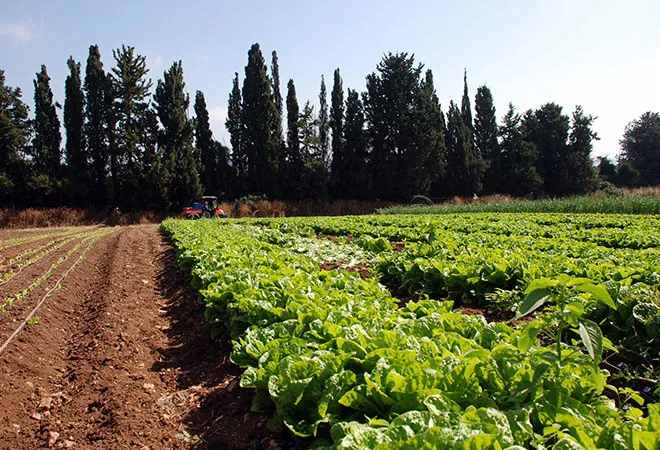
Food security is key in an age of uncertainties. Growing climate-related risks, geopolitical tensions, and macroeconomic shocks make imports costlier than ever before—in both tangible and intangible terms. India’s agriculture sector’s GDP
stands at US$ 262 billion (as of 2018-19), demonstrating a low dependence on imports. Achieving self-reliance and sustainability in agriculture has led to a critical policy switch. It has enabled a shift from increased food grain output being the sole point of focus to improving farmer incomes. This is also expected to promote farmers’ welfare, allowing farmers to adopt technological inputs into existing agrarian processes, especially for mitigating loss and damages to agricultural produce through innovative agri-tech solutions that can minimise losses along the lifecycle of agricultural commodities.
As a critical pillar of India’s social protection programmes, nearly 80 percent of the country’s population depends on food grains/ration supplies.
The focus on farmers’ welfare serves as an unprecedented opportunity for the domestic market to overcome structural challenges such as climate-related risks, post-harvest losses, and the lack of agricultural infrastructure by enhancing the penetration of India’s cold chain industry to rural areas. As a critical pillar of India’s social protection programmes, nearly 80 percent of the country’s population depends on food grains/ration supplies. Whilst 5-7 percent of India’s food grain production is wasted due to procedural inefficiencies, this number is higher for fresh produce with an
estimate of losses amounting to about 11 percent. Cold storage infrastructure and supply chains are an example of foundational interventions that can propel food processing industries, whilst simultaneously enhancing the diversification of crops with farmers being able to lengthen the shelf life of fresh produce. Similarly, increased focus on addressing critical bottlenecks, such as poor quality of power supply and low access to finance for agri-tech inputs are adding to the woes of the agricultural sector.
Prolonged heat waves and an increased frequency of extreme weather events such as floods, droughts and cyclones are also resulting in increased quantum damage-related expenses. Generally, hot and humid conditions in India also exacerbate the maintenance costs of cold storage facilities. The focal point of building agricultural resilience lies in limiting the wastage of power, water, and post-harvest produce. This article highlights a three-point agenda of reforms to enhance innovation in agri-tech by minimising wastage across the lifecycle of agricultural commodities.
1. Resolving problems of poor-quality power supply to enable water-conserving irrigation:
Over the years, inaccurate estimations of electricity consumption have led to untargeted approaches being applied to optimising the power sector, resulting in the persistence of problems like unmetered consumption, incomplete separation of feeders and Aggregate Technical and Commercial (AT&C) losses. While rural electrification programmes in India have succeeded in providing
near-universal household access to electricity, the discourse is now shifting to providing reliable and quality supply, and round-the-clock power to all. This is essential for not only households but also for agriculture, which struggles with implementing innovations such as drip and sprinkler irrigation on account of sketchy and unreliable power supply. With respect to agriculture, cultivation methods have hence remained largely traditional in areas with irregular electricity supply resulting in the wastage of water resources. Once we can cut losses in the power sector and ensure better quality power supply, even for a few, predictable hours a day, farmers will be able to confidently install drip and irrigation networks without adverse costs.
Installing a drip irrigation system costs INR 50,000/acre and requires eight hours of continuous electricity, as compared to a flood system where water is piped into the field for days. The practice of flood irrigation is largely prevalent even today and it has a reinforcing impact on the depleting levels of groundwater, which, in turn, aggravate drought conditions. Moving to micro-irrigation will optimise costs on water and electricity inputs for farmers in the long term, freeing up financial resources for investment in post-harvest technologies.
Cold storage infrastructure and supply chains are an example of foundational interventions that can propel food processing industries, whilst simultaneously enhancing the diversification of crops with farmers being able to lengthen the shelf life of fresh produce.
2. Using public and private sector solutions to mainstream cold chain facilities in rural and semi-urban India:
Recognising the potential for developing the cold-chain industry in India, especially for its role in limiting wastage of post-harvest agricultural produce, the Union government has recently provided a much-needed push by approving 27 projects under the PM Kisan SAMPADA Yojana (PMKSY) scheme for integrated cold chain and value addition infrastructure, which is estimated to provide direct and indirect employment for 16,200 farmers. Despite its initial success, the wider adoption of cold storage systems requires an additional push, especially through market-driven approaches that complement government support.
Cooling-as-a-service is a global innovation in this regard, where local cold-chain technology providers own, maintain, and operate cooling systems in a decentralised manner. In India, this innovation has been piloted through the Your Virtual Cold Chain Assistant programme, conceptualised to minimise post-harvest losses through the decentralisation of cold storage facilities. The programme ensures that storage rooms rely on energy-efficient equipment, and also keeps farmers informed of the remaining shelf-life of their stored crops and market price predictions using e-NAM and other open sources, helping (i) farmers plan better, and (ii) cold storage providers a stream of revenue.
3. Expanding access to finance for private sector solutions:
As the linkages between food security and climate change are manifesting prominently, developing economies need to catalyse actions on minimising food losses, in the context of national food security goals. Given that the problem is more pronounced in the developing world, it is imperative that (i) global finance pledges and the
architecture of financial flows be changed to allow an increased flow of funds to the Global South. At a domestic stage, medium- to long-term debt financing facilities for investment in viable projects for post-harvest management infrastructure and community farming assets, like the
new Agriculture Infrastructure Fund (AIF) must be developed to accelerate change in this direction. The operationalisation of
resilience bonds can be quickened to finance activities that build municipal resilience and contribute to climate change adaptation such as addressing loss and damage. Lower-risk instruments such as this help diversify and distribute the impact of damage amongst investors, while at the same time financing investments that improve farming practices, spur innovation in agri-tech, and enable resilient physical infrastructure building.
With respect to agriculture, cultivation methods have hence remained largely traditional in areas with irregular electricity supply resulting in the wastage of water resources.
If the pattern of extreme climate events across India in the last five years is anything to go by, we need a thorough upgradation of storage facilities (especially in rural areas) that can minimise losses in power, water and post-harvest losses, by expanding access to finance for climate resilient technology adoption. We need to smoothen access points for private sector innovations that can share the burden of improving agricultural resilience and complement public sector actions. It is time we acknowledge the role of modern solutions in overcoming food insecurity, enhancing access to nutrition and ensuring long-term food sector sustainability.
The views expressed above belong to the author(s). ORF research and analyses now available on Telegram! Click here to access our curated content — blogs, longforms and interviews.



 Food security is key in an age of uncertainties. Growing climate-related risks, geopolitical tensions, and macroeconomic shocks make imports costlier than ever before—in both tangible and intangible terms. India’s agriculture sector’s GDP
Food security is key in an age of uncertainties. Growing climate-related risks, geopolitical tensions, and macroeconomic shocks make imports costlier than ever before—in both tangible and intangible terms. India’s agriculture sector’s GDP  PREV
PREV


